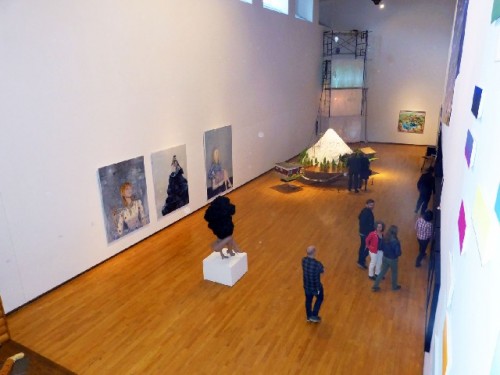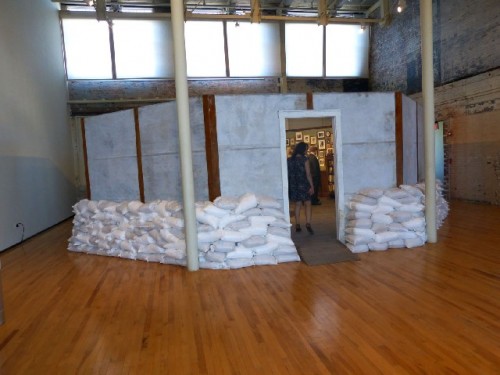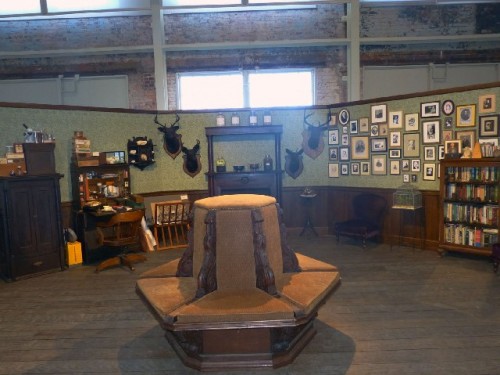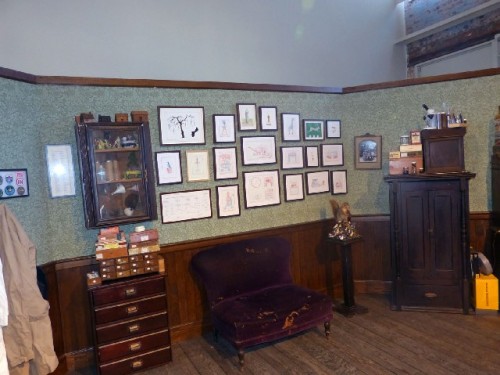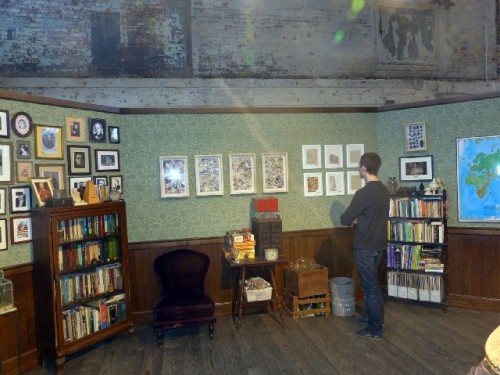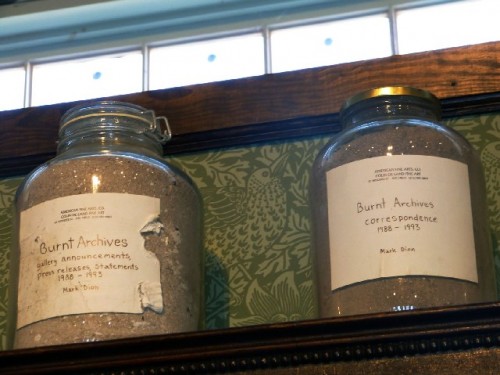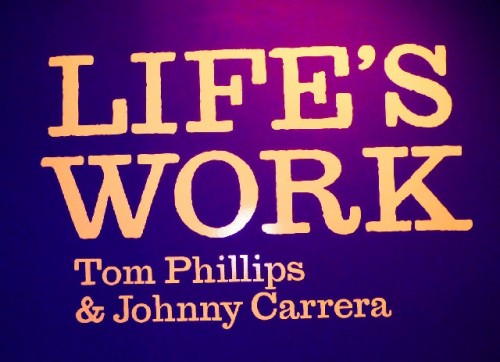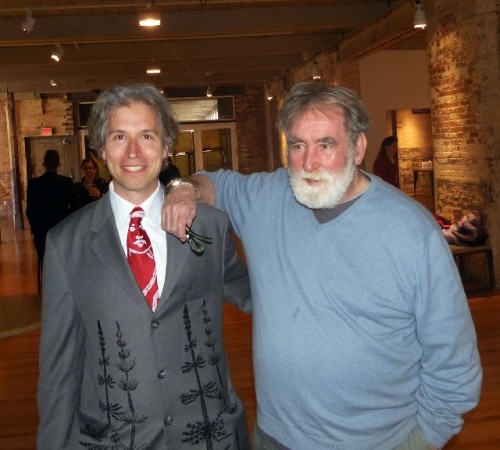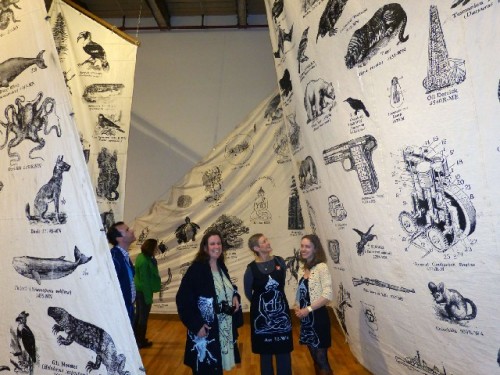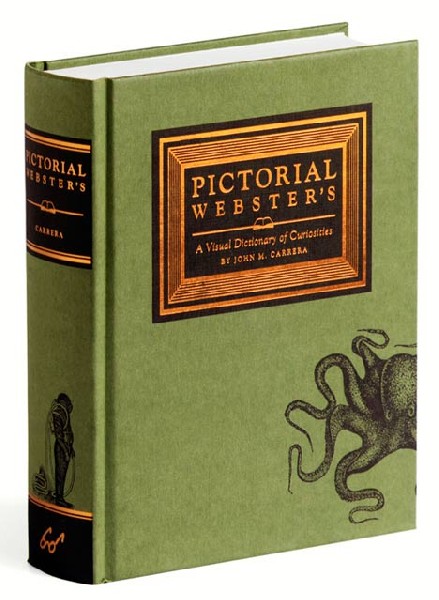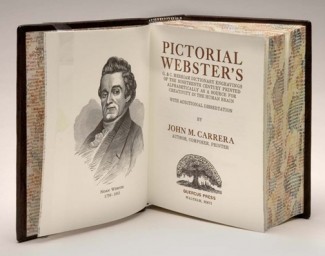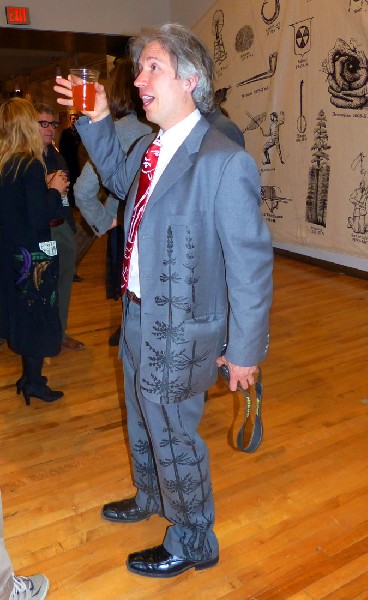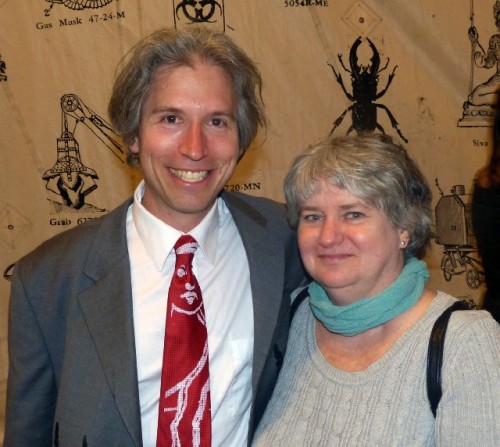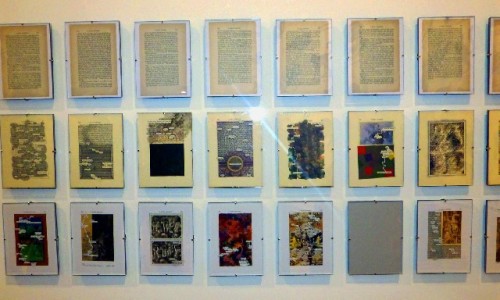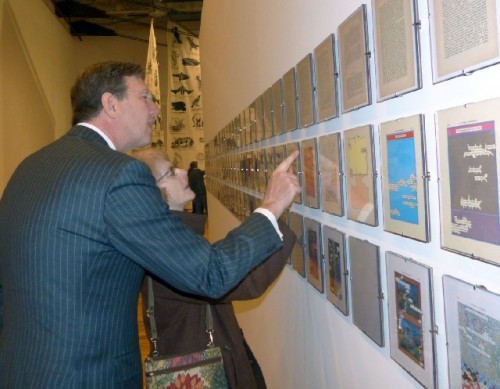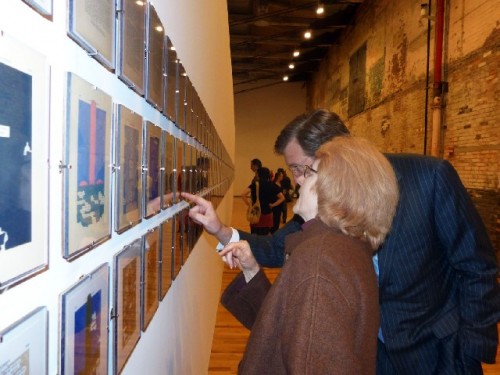MASS MoCA’s Timely Reboot
Closes Oh, Canada and Opens Three Exhibitions
By: Charles Giuliano - Apr 07, 2013
Yesterday, in an event dubbed “3,2,1” MASS MoCA launched its spring initiative despite unseasonably brisk weather during the 2013 Berkshire winter that just won’t quit.
There was a member’s opening reception, with a silent auction in the lobby, followed by dinner under the enormous steel sculpture of Xu Bing in cavernous Building Five, capped by grooving to platters spun by Canadian DJ, King Khan in the Hunter Center.
The gala evening celebrated the opening of three exhibitions - Mark Dion: The Octagon Room, One Minute Film Festival: 10 Years, and Life’s Work: Tom Phillips and Johnny Carrera - and closing of Oh, Canada which has been on view for the past year.
We recognized several of the Canadian artists including Brendan Fernandes, Mitchell Wiebe, and Graeme Patterson. They will be packing up this week.
The elaborately detailed Mountain a fantasy artist’s workshop with tiny details by Patterson was a superb work praised by most of the reviewers. I couldn’t help but ask the personable Patterson, who wears a signature cap over a thick mop of hair, if he had read my review. He did and liked it.
Overall, he commented that the American reviews were more interesting than the Canadian ones. Scribes in the U.S. were less bogged down by politics. In particular, he was pleased with Sebastian Smee wrote about his work in the Boston Globe.
We wanted to know if the exhibition, the first museum level exhibition in the States to survey Canadian art, had any significant impact on his career? Did it lead to new opportunities?
Mostly that evoked a shrug. While it was nice to have the opportunity and exposure it was hardly a game changer.
We asked if he teaches or how he supports himself? Charmingly, he responded that he lives on earnings from the work however modest. That’s made possible by a simple lifestyle in a village of some 2,500 near Moncton, New Brunswick. “It’s still relatively cheap to live there” he commented. But what about the cost of heat during the long winter? He responded that wood is his fuel and that it is readily affordable.
It is rare that we have a second chance to interact with artists in special exhibitions but we were intent on experiencing the new works.
In that regard there were mixed feelings about yet again encountering work by Mark Dion who, by now, is over exposed and appears to be recycling concepts with new components but familiar ideas.
His bunker like The Octagon Room is set up in a large gallery shared with a long term installation of a work by the seminal German artist Joseph Beuys. Initially, it occupied the entire space but now has been compressed to allow for displaying new works.
Surrounding the white exterior walls of The Octagon Room is a perimeter of stacked sandbags. It evokes the notion of a bunker under siege perhaps a signifier of the Great War. The assortment of vintage ephemera in an ersatz, eclectic office mostly dates from the era of the 1940s. Some of the newer objects, large jars with specimens of water dredged from various locations, have been distressed to give an aged sensibility that blends in with the ambiance.
The initial impact is a step back in time to a study of someone involved with science and nature. There are lots of things to examine. We are enticed to play Sherlock Holmes trying to find the clues to an interpretation of the meaning of the room. Things are not always what they appear to be. For example, the stuffed heads of deer are covered with some odd sculptural material obscuring their original fur.
While there is the perennial delight of yet another evocation of a Wunderkammer, the original museums as cabinets of curiosities, there is also the ennui response of Yogi’s déjà vu all over again. Those less familiar with Dion’s work will no doubt be intrigued.
Coming up the stairs to the second level we were surprised by a sign and perky intern informing us to "leave drinks here." Point was we didn’t have any drinks. Where’s the bar was the inevitable question to the young lady? She apparently fielded a number of such inquiries. "Up there" was the response pointing to stairs leading to the upper galleries.
Emerging into the space we encountered Life’s Work: Tom Phillips and Johnny Carrera which we would soon unravel. But first things first. Drinks and snacks.
The serving area was set up opposite a long, free standing, rectangular wall with three horizontal rows of small, framed drawings. Pages from books as we learned.
Fortified with booze and nibbles I turned the corner expecting to find an inner space. But instead discovered the other two sides of a long, relatively narrow rectangle. The neat, three rows of small frames circumvented the entire space. That entailed hundreds of individual images to examine. It’s a demanding task where one tends to see the whole rather than the sum of its parts. Particularly during an opening.
We encountered Joe Thompson, the director of MASS MoCA who was talking with a curator from The Frances Young Tang Teaching Museum and Art Gallery at Skidmore College.
Thompson led us to the array of images by Phillips and involved us in their mysteries and obsessions.
Forty years ago Phillips purchased several copies of A Human Document, a Victorian novel by W.H. Mallock. On the top row the book has been taken apart and each page framed and hung in sequence. Had one the time and patience it would be possible but unlikely to read the novel.
In the middle and bottom rows, as Thompson explained, the artist has altered the original pages with overpainting and collage. Some of the original words and sentences have been retained. Each band represents a new edition of the novel and by this selective process the second and third alterations of the original become a new work of literature by reduction.
While the notion is intriguing we don’t imagine many MoCA visitors “reading” these second and third versions of an obscure Victorian novel. Arguably, it is the visual arts equivalent of Albert Camus’s 1942 Myth of Sisyphus an essential treatise of existentialism. Or the Buddhist text of Songs of Milarepa. These works of literature describe the process of consuming, repetitious tasks that equate to an understanding of the cycles of the wheel of life. In philosophical and religious contexts such endless tasks represent a process toward enlightenment.
In the context, as presented by curator Denise Markonish, this endless tasking with no end point is understood as Life’s Work. As art, it doesn’t have to make sense. The conundrum is that the artist pursues an endless, unlimited task through free will. Consider the millions of workers in factories who spend their lives on monotonous assembly lines. What meditations and mantras get them through days, months and years with no enlightenment, other than a pay check, at the end of the tunnel.
To quote T.S. Eliot it underscores the humdrum of our lives in which "And time yet for a hundred indecisions, / And for a hundred visions and revisions, / Before the taking of a toast and tea." Or the Biblical “A time to plant/ a time to sow/ a time to pluck up that which is planted.”
So is Phillips’s MASS MoCA piece about passages? The years it took to create the obsessive work and its challenge for viewers. The work signifies the duration of patience and stamina required to experience it. How many of us opt to push that boulder up the mountain over and over again?
Compared to which the obsession of Johnny Carrera, while daunting, was more accessible. The artist, who wore a suit decorated with a selection of silk screened images, proved to be a charming, eccentric, passionate and absorbing ambassador of his twelve year project to deconstruct and recreate The Pictorial Webster's Dictionary which is available through Amazon.
There were a number of visitors wearing jackets with one of his images silk screened on the back. We also encountered many MoCA associates wearing his emblazoned t-shirts. With whimsy he told me that he enjoyed seeing his work walking around during the opening.
Like Phillips the project was launched by a chance encounter with a book. He found an 1898 edition of Webster's Dictionary in his grandmother's stone farm house in 1995. In contained an 80-page section of illustrations. Research of the engravings led to Yale University’s 10,000 original engravings which are about an inch or so each.
Through the artisan’s program of the North Bennet Street School in Boston he learned the craft of book binding. There is a video in the exhibition which illustrates the phases of this process.
For a time the artist resided in a loft studio complex in Waltham, a suburb of Boston. There he installed his grandfather’s printing press and started to make images from vintage engravings. Over time these were compiled into the book with a pocket version to be published his summer.
The artist Joan Kiley, a resident of the Eclipse Mill in North Adams, told me of many years as his neighbor in Waltham. She was delighted to reconnect with the artist who now resides in Maryland to be closer to family.
When Markonish approached him about a MASS MoCA exhibition that represented a new challenge. How to expand from the intimate scale of the original illustrations and make sense in the vast space of the museum.
He explained to me, during an animated and amusing conversation, that many of the dictionary illustrations derived from an era of sail, whaling and maritime trade. He hit upon the notion of putting a range of enlarged images on recycled sails. This meant that he had to teach himself the techniques of silk screen printing. The absorbent surface of recycled Dacron sails created complications in getting the right density for the ink resulting in sharp impressions.
While the sails were a clever solution he came to realize that a vertical, Marconi rigged, triangular sail was too tall for the dimensions of the space however vaulting they appear to be. He pointed out that the top of one had been cut off. That left a less sail like configuration. And a terrible pun when I asked if he had made any ‘sales” lately.
It was Dada humor and the artist didn’t mind. What about the semiotics I pressed on? Is this just a configuration of random vintage images evoking their own charm and nostalgia? Would this all add up to something heavy duty? Thinking gives me headaches I informed the artist pulling his leg.
Not surprisingly, the past dozen years of intensive work was indeed about something. Depressing actually as he explained. The dictionary images included many illustrations of species, which while populous at the time, are now endangered or extinct.
He pointed to an image of a chinchilla, a small rodent prized for its fur, which once existed abundantly in the wild and is now available in pet stores. “Is that what he have come to” he asked rhetorically. That led him to include icons and signifiers of man’s devastation of nature from guns to an electric light bulb.
All of which may not be readily discernable to the average museum visitor. Fortunately, as a neighbor of Mass MoCA, over the next year there will be time to absorb the ecological inferences of Carrera’s sails, prints and books. On a rainy afternoon I might even start reading deconstructed chapters of Phillips' sprawling books.
Time is of the essence.
With my artist friend Robert Henriquez we continued to the upper level galleries for a brief encounter with One Minute Film Festival: 10 Years. We gave it a few minutes. It documents The One Minute Film Festival which took place annually in a barn outside of a small town in upstate New York, on the first Saturday after the 4th of July, from 2003-2012.
It includes a special exquisite corpse film for year 10. This hour-long film was created by artists each receiving the last second of a previous film and building a new minute based on that glimpse.
Participating artists include Peggy Ahwesh, Judith Barry, Gregg Bordowitz, Todd Beecraft, Chris Brunt, Megan Cump, Eric Davis, Peter Cole, Anna Craycroft, Adam Simon, Shit TV, Robert Williams, Sowon Kwon, Alex Yalakidis, Martin Beck, Moyra Davey, Ewa Einhorn, Su Friedrich, Alice and Della Wilsey, Angel Nevarez, Bill Burns, Aaron Namenwirth, Anna Hansflen, Andrea Fraser, Daphne Fitzpatrick, Josiah McElheny, David Dempewolf, Bill Stone, Myrel Chernick, Jimmie Durham, Jon Kessler, Hope Ginsburg, Jennifer Montgomery, Matt Dugan, Lenka Clayton, Klara Hobza, Mark Dion, Christy Gast, Claire Pentecost, Barbara Bergstrom, Perry Bard, Ellen McMahon, Holen Kahn, Sam Lewallen, Roddy Bogawa, J. Morgan Puett, Dana Sherwood, Amy Yoes, Valerie Tevere, Matthew Buckingham, Liza Philips, Karin Felbermayer, Jorge Colombo, Andrea Geyer, Julie Ault, Sean Reynard, Francis Cape, Bob Braine, Francisca Benitez, Raina Benoit, Catherine Berg, Jacob Borndal, Pat Carullo, Dennis Balk, Cathy Clarke, Anne Colvin, Shea Craig, Megan Cump, Pradeep Dalal, Richard Elovitch, Kelly Fancher, Erik Freeland, Marc Ganzglass, Dave Gearey, Michael Gitlin, Chelsea Goodchild, Mitchell Goodman, Jackie Goss, Thersa Hackett, John Haskell, Sharon Hayes, Liza Johnson, Iain Kerr, Athena Kokoronis, E.M, Langer, Eli Langer, Jerry Lerner, Lana Lin, Lan Thao Lam, Jeff Luckey, Keith Malik, Babette Mangolte, Amanda Mattes, Yvette Matern, Richard & Eric Metzgar, Ulrike Muller, Julia Murray, Molly Nesbit, Jaye Nydick, Jason Protass, Michael Owens, Rebecca Purcell, Gary Graham, William Bryan Purcell, George Quasha, Lucy Raven, Fay Ray, Larilyn Sanchez, Jeff Silva, Sherry Williams, Pawel Wojtasik, S. Wolle and hundreds of others.
Let’s leave with the Stones.
Time is on my side, yes it is
Time is on my side, yes it is
Now you always say
That you want to be free
But you'll come running back (said you would baby)
Youll come running back (I said so many times before)
Youll come running back to me
Oh, time is on my side, yes it is
Time is on my side, yes it is
Youre searching for good times
But just wait and see
Youll come running back (I wont have to worry no more)
Youll come running back (spend the rest of my life with you, baby)
Youll come running back to me
Go ahead, go ahead and light up the town
And baby, do everything your heart desires
Remember, I'll always be around
And I know, I know
Like I told you so many times before
Youre gonna come back, baby
Cause I know
Youre gonna come back knocking
Yeah, knocking right on my door
Yes, yes!
Well, time is on my side, yes it is
Time is on my side, yes it is
Cause I got the real love
The kind that you need
Youll come running back (said you would, baby)
Youll come running back (I always said you would)
Youll come running back, to me
Yes time, time, time is on my side, yes it is
Time, time, time is on my side, yes it is
Oh, time, time, time is on my side, yes it is
I said, time, time, time is on my side, yes it is
Oh, time, time, time is on my side
Yeah, time, time, time is on my side

